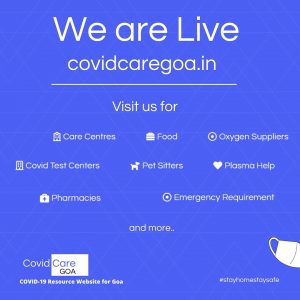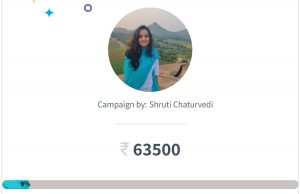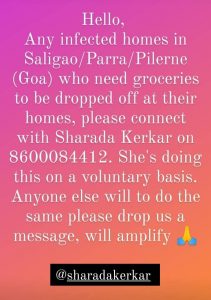Act for Goa gets Felicitated
Posted on 08/12/2022Several people have stepped up to help in COVID relief work, helping affected families with arranging supplies, plasma, COVID beds and so on.
Using social media effectively in times of the pandemic
Shruti Chaturvedi has been using her social media platforms to amplify the requirements for food delivery, oxygen cylinders, pharmacies, plasma and so on. She’s put together lists for the same, to help those in need. “I put together a Goa resources toolkit to help Goans find restaurants and home cooks who can make hygienic, nutritious food for COVID patients and deliver it, Goan volunteers who can help run errands for patients, a network of pharmacies and oxygen providers who update their stock every couple of hours and deliver medicines in their areas and a network of plasma donors, so that needy patients and their families can find verified contacts in the time of need. I have connected with people in COVID hospitals who are helping me with real time information on whether they have beds available or not.”
Furthermore, the google sheet that Shruti created along with her mobilised 50+ volunteers is now a website. covidcaregoa.in
It essentially consists of all the data that they think people need in the time of Covid-19 emergency and verified (as best as possible since this is a manual intervention) on a daily basis to avoid wasting peoples time in the time of emergency.
On the website you can find:
- Verified numbers of #testlabs
- Verified numbers of #ambulances
- Verified numbers of home chefs and restaurants delivering #food for COVID-19 patients
- Verified numbers of #Pharmacies and who delivers essential covid medicines at your doorstep
- Verified numbers of #petsitters to take care of your pets when you get COVID-19 ?
- Verified numbers of COVID #care centers
- Verified numbers of #Oxygen Suppliers
- #Plasma resources
- Numbers of their #volunteers who can help you get essentials delivered if you’re COVID-19+
The site also has details on Home Isolation, plasma enrollment form, link to their excel for more real time data as they make our site more data dynamic (bit.ly/COVIDGoaResources) + a link to their emergency relief group (bit.ly/CovidGoa) if one is unable to find help there.
Lastly, they also have a ticker running with vital notifications, FAQs on how to look after yourself through this, how to look up resources on the site and a link to a crowdfunding campaign (gocrowdera.com/covidgoa) to help those who can’t afford it
TEAM COVID CARE GOA
1. How did the 40 volunteers who initially started out become aware of their mutual interests and come together?
April 19th 2021. Not so long ago. Enquiries relating to the burgeoning Covid-19 crisis in Goa were on the rise. As the situation started to escalate in Goa, inquiries and conversations began on Twitter and other platforms around a Goa specific resource list. Safe to say, Goa doesn’t have the most robust healthcare infrastructure and with so many people travelling in and out of the state, sometimes seeking refuge in Goa with the pandemic worsening in other states, many of us were starting to fear the worst.
Several of us intimately linked within local community networks and formerly involved in relief work were already mobilising on the ground. Then there’s those of us online who started talking to each other. For instance, Shruti Chaturvedi, through her platform and outreach on Twitter and Instagram which is fairly large, floated the idea to curate resources and volunteers via a series of Google Forms she put out to begin the process. Volunteers like myself and countless others connected. Both sets of volunteers came together on one platform that became Covid Care Goa.
Of course, on the supply side, critical resources like pharmacies, oxygen suppliers, test labs etc. weren’t always going to self-enlist so data entry volunteers then started calling them proactively area-wise to scour availability, delivery options, timing etc. with SOPs in place about the kind of questions to ask, the cycle of reverification, colour-coding depending on change of status etc.
A master Google spreadsheet with these expanded to multiple tabs as we added other information in the public domain that we then verified like hospital and nodal officer numbers, home nursing and CT scan, shops for essentials, oximeters, teleconsultation, ambulance services, funeral services, pet sitters, sanitisation services and so on.
Within 6 days of starting and scaling, volunteers on the web design and content side created a web frontend for all this data and we built FAQs on covid care, government notifications, additional helplines etc. on top. Volunteers on emergency relief were already in their relevant WhatsApp group which the public in need could access for their bed and plasma requirements. For everything else the website data and FAQs sufficed. And the delivery volunteer network on another closed WhatsApp group was activated by the team leads in emergency as and when the queries they got merited feet or fleet-on-street. We needed to be careful not to over expose volunteers and obligate them for on-ground duties considering the risks involved so they had complete autonomy to decide and we also procured safety kits for them.
Additional sets of volunteers who were connected with NGOs and hospital networks and were fast acting took on proactive initiatives like running blood donation camps, signing up plasma donors and food deliveries at hospitals themselves among others. These were the “spikes” in the overall relief campaign that we could make quick decisions on and simply action.
Overall, these kinds of mechanisms and decisions have been evolving with the initial core group. We created SOPs as we scaled from a start-up like setup to some form of organisation. This was critical so existing verticals could run smoothly with more volunteers coming in with minimal time loss in briefing and maximum efficiency. The core group could then focus on continuously building and scaling new ideas under the relief programme ideas.
2. Could you elaborate a little more on each of the varied activities that Team Covid Care Goa has been involved in? For example, how you reached out to engage ambulances and bring in supplies of oxygen cylinders.
Things are simpler than they appear. Search phrases for all of these resources in different areas of Goa on Google search yielded numbers. Thereafter, a process of data verification ensued. If the numbers were answered and legitimate, a line of questioning followed. For eg., in the case of ambulances, their source location and routes, timings, what in-ambulance services etc. were provided etc. and then put down. Then a system of reverification, first on a daily basis, and then once in every 2-3 days as resources started inevitably becoming scarce and we couldn’t risk putting them off with constant calls anyway. As it is those in need were calling them every so often. Over time, we also left the verified spreadsheet which had currently become unavailable, not answering and so on statuses against resource entries, linked at the bottom of the website so that the wider public could access the entire database at large. After all, real-time in times like these is also relative.
For things like oxygen cylinders, concentrators and so on, as we gained visibility, beyond data listing and facilitating with emergencies, a crowdfunding campaign was run to curate physical resources for institutions like hospitals and other legitimate governing bodies at the local level. It was started by Shruti Chaturvedi while the core group of Covid Care Goa with their myriad skillsets are advising her on what to procure, how, facilitating procurement and deciding to what end, ensuring complete due diligence and institutional handovers. With credibility established, and with various volunteers also being connected to other relief groups and suppliers across the country, we got the additional facilitation we needed. In some cases they were funded, as with oxygen concentrators from the campaign proceeds. These will be put into circulation via government hospitals themselves.
In other cases, donors who could see proof of concept through our relief efforts and the attention we were bringing in to other structural, systemic issues like supply shortages at the GMC and building pressure by way of offering our own help to government bodies and parties across the spectrum, thought kindly to donate through us. Recently 30 oxygen cylinders came in from Bombay to Goa via a foundation. We simply handed these over to the hospitals.
3. How would you describe the spirit and activity of the volunteers involved. Would you say the state/those who are interlinked in their activities share the same spirit and are providing the necessary support?
Since the personal motivations for each person volunteering beyond a sense of altruism are, in fact, personal, I can’t speak to them all. Many of them have roots here, strong local ties, affiliations and have done relief work in their communities before, naturally compelled to go on. Many have made Goa their home in the last few years, have achieved a degree of success and have forged networks between their home state and Goa, and so they can innovate and tap into them. Some are entirely new here and are motivated to act because that’s all they can do, when nothing else feels familiar or comfortable in a time like this.
Overall, the spirit and activity have consistently been about just getting things done and getting them done right – which means justly and well. And that automatically weeds out not doing a lot of things like keeping equipment with us for direct aid (redirecting it to hospitals for eg.) since helping specific individuals over others on the day is an ethically unviable prospect.
Our objectivity has been tested, our spirits have flagged, there’s always arguments and a lot of conversations but we think through things, notably the big stuff, so we do not lose momentum as we scale. This kind of mindfulness amongst folks who don’t know one another and despite our strong personalities has been eye-opening for us all. And tells us that we CAN do the right thing if we make that our iron-clad intention.
As for state support, we have volunteered it to the government of the day. We also routinely tag and amplify the work that all parties are doing after verifying, including opposition parties, for awareness since we understand no one can do this alone at this stage. And this is about ensuring intended beneficiaries of various initiatives, state-sponsored or otherwise, get it. We are ready to help, should they co-opt us. Of our own accord, we set up processes to check 02 supply availability at GMC at regular intervals through the course of the night when the situation become extremely dire and flag it off through a series of escalations including to PROs, nodal officers, lawyers and police officers so we could both help with monitoring and intensify pressure by amplifying status and ensuring resolution. We believe this has to be the spirit shared by all agencies and government parties. There is no other option now especially when much is left to be done. We have to work together and through your platform, we’re offering our help again.
4. What were the major challenges in the team’s journey through this pandemic?
The major challenges have remained extraneous to us and really, intrinsic to the healthcare system, the latter unfortunately being woefully inadequate.
Tried our hardest we could, but there was simply no fix for things like bed availability, ICU and ventilator beds, enough intensivists or contingency plans for any unforeseen glitches in the central oxygen and power supplies and abject conditions in the facilities themselves. We could only draw attention to these relentlessly on social media, in the press, via petitions and even direct outreach, willing those responsible in the chain of command to help manage, streamline and build atop of. Even things at two ends of the spectrum – preventive action like strict lockdowns and clamping down on interstate travel or reactive action like covid care centres that came up, having not just beds that limits the line of treatment to asymptomatic patients only but building oxygen supply capabilities in them, and as a last recourse, allowing patients to use them after procuring their own supply – these are the kinds of ideas and conversations we’ve tried to pay forward.
We’re not policy makers or enforcers after all. So we focused on building enough awareness, reminding the public of measures that they could take to stay safe, allay their panic and fake news and provided them access to home care protocols and care personnel, teleconsultation facilities and equipment like oxygen cylinders, concentrators, regulators etc., so they could manage their care as best possible in their homes and not have to head to a hospital in the first place.
Ultimately though, this is the piece of the puzzle that cannot be helped beyond a point. We’ve even tried to facilitate the routing of life saving equipment through community centres etc. with wonderful groups like Sabrcare and others as well so again, we reduce the burden on an already overburdened system and make the logistics efficient. There have been several times when a patient has had to be ferried from North to South Goa and back to no avail. There’s not much else we can do about building solid infrastructure and on the day, losing a patient feels like a crushing blow.
Now, while we’ve seen some momentum build on fixing the structural glitches given all the discourse and pressure, there’s always the next major challenge. The long tail and slow work of rehabilitation for folks who have been affected by covid-19, the cyclone or both, by way of having ailing members or loss of members who would be earning, those who are financially reeling and need financial care packages, whose families and homes need looking after and some form of work so they may sustain themselves. We hope to be able to help with these efforts as best we can. Given the due diligence, compliance, scale and spread this kind of work needs, we hope the powers that be proactively take this up.
5. What are the ways that you feel the community can reach out? Especially with the pandemic in full swing, we have seen many wanting to take part actively in some form of service.
Through distilling the process, I hope everyone can see that it can be organised and made manageable. I will admit, it is an exhaustive endeavour and many of us have put our lives on hold for it, working 14-15 hours on most days. So many on the frontlines putting their lives on the line. Even in the midst of the cyclone, we had delivery volunteers helping people in need. No endgame that benefits us, except that we may save some lives.
Ultimately, this was about 4 big verticals – data, emergency services, content and amplification and further outreach on-ground (helping folks in need with all kinds of requirements to camps and food setups outside key hospitals etc. to now even procuring resources via fund raising that can be routed through them with due diligence and need assessments done). So first there’s knowing that whatever you start, you have to make it count and it helps to have some sort of plan.
Nothing this fleshed out at the outset because too much planning can get in the way of beginning. However, given the kind, scale and duration of crises that are erupting, and the lack of resources, planning and leadership from those who are tasked to provide these, hopefully this blue-print helps. We even have a programme kit that I will be sharing in due course because we need to accept that this is just the way things will remain for sometime, so if we want to help, we have to stay committed and organised. In its WIP avatar, it has already been socialised to some other relief groups in other states.
Not to say that anything less is unhelpful or that we need to stand-in for the powers that be. That is a burdensome and unrealistic stance to take. Everyone’s struggling in their own lives at and I think even just looking out for each other is more than enough. So, as far as individuals go, kindness goes a long way. A lot of fear and misinformation prevent us from doing right by our neighbour. This has to change. Our efforts are also morphing from a model of few-many to some-some, better yet, 1 – 1.
If every person stood up to just help the person living next to them who may be affected – could be a single meal sent over, some medicaid provided, a friendly check-in, some sanitisation protocols managed on their floors or buildings, help with commute in an emergency, just staying vigilant and keeping people informed about any verified news or developments that could affect their neighbourhood – we could make a huge difference.
– Covered by Zaira Mirza (Act for Goa Volunteer)
– Questions answered by Parul Soni (Covid Care Volunteer)
Youngsters step in to help reach supplies
Sharada Kerkar, who’s helping infected families in home quarantine with groceries and errands, says, “The world around us is crumbling. Helplessness is rising and hope depleting. In such a situation, one must do whatever little they can to restore faith in humanity. People who are reaching out are panicking and overwhelmed . It’s not easy for them, and they’re thankful of any help received.”
Several content creators and influencers in the state are also using their platforms to spread awareness on donating plasma and staying safe, amplifying the requirements for COVID beds, plasma, Remdesivir, food/supplies for affected families and so on.
Information Source:
- https://timesofindia.indiatimes.com/entertainment/events/goa/people-in-goa-get-together-to-help-those-with-covid/articleshow/82227388.cms?from=mdr
- Parul Soni (volunteer with covidcaregoa)









